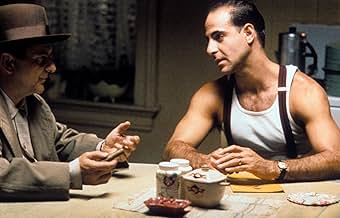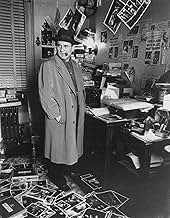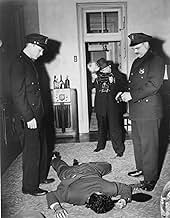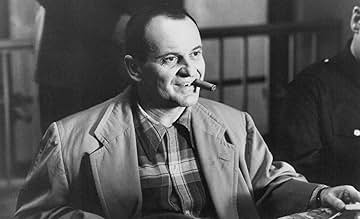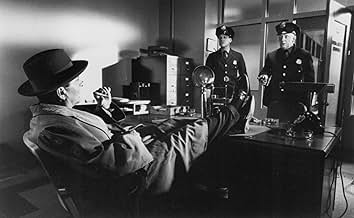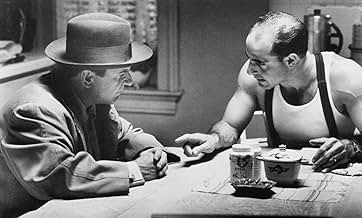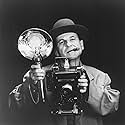VALUTAZIONE IMDb
6,5/10
4747
LA TUA VALUTAZIONE
La storia di un fotografo degli anni '40 del Novecento che si è specializzato nel crimine e non si è mai lasciato coinvolgere, tranne questa volta.La storia di un fotografo degli anni '40 del Novecento che si è specializzato nel crimine e non si è mai lasciato coinvolgere, tranne questa volta.La storia di un fotografo degli anni '40 del Novecento che si è specializzato nel crimine e non si è mai lasciato coinvolgere, tranne questa volta.
- Regia
- Sceneggiatura
- Star
- Premi
- 1 candidatura in totale
Christian Stolte
- Ambulance Attendant
- (as Christian Stolti)
Gian-Carlo Scandiuzzi
- Maitre D' - Cafe Society
- (as Gian-Carlo Scanduzzi)
Recensioni in evidenza
This is a wonderful piece of work. The visual look of the movie is simply fantastic. But it should had been better if it was in black and white! In this case, Public Eye could be seen as a 1930's gangster movie. But the color of this movie looks like black and white. This film had anything I love about the Bogart, Robinson and Cagney movies. It's also give a chance to Joe Pesci to plays perhaps the role of his life. He's fabulous! Hard cigar smoking little guy ain't afraid of anything to have a good photography. He thinks big cities photos is art. He's also very moving, in the way Ernest Borgnine was in Marty, when he falls in love with wonderful Barbara Hershey. This is a great movie, one of the best American movie of the 1990's.
9sg60
I first saw The Public Eye about ten years ago knowing nothing about it in advance. This movie has really stayed with me over the years. It's very rich in atmosphere and I really bought into the characters. The whole cast was strong and the writing was very good. I read one review that complained that the romance wasn't believable. On the surface that might be understandable but the quality of the acting and the writing completely erased the issue for me. The 1940's setting was portrayed very effectively and the music added so much to the story. The scene with Kay Levitz going through Bernzini's photo album was very moving and captured the whole story in a nutshell for me. I strongly recommend this forgotten gem.
I appreciate that this film was more than a homage to film noir but actually advanced the genre to include populist themes and even women's issues. In many ways, this is film brun because so much effort is made to evoke the brown tones of the time which brought a warmer, less paranoid tone to the proceedings. Brown can be earthy or rich. Men wear brown suits and hats and chew on brown cigars. The nightclub is paneled in rich brown wood. Kay Levitz has brown hair. The script and direction showed a love for the time but a cynicism, too, of government collusion with organized crime to make money at the expense of the fighting men and the citizens during a time of war. I enjoyed the relationships between the characters and was touched by the pan of the cheering crowd of real people at the end, not usually seen in noir. To add to the comments about the actors: I also enjoyed Jerry Adler as Bernzini's friend and was intrigued by Jared Harris's Danny the Doorman.
Joe Pesci plays the role of Leon "The Great Bernzini" Bernstein with accomplishment, as a kind of grubby, middle-aged everyman. Barbara Hershey, 44 when she made this movie, makes the screen sizzle by her mere presence as Kay Levitz. Pesci probably should have gotten an Oscar nomination for this performance, which is understated, sincere, and totally convincing. Some of the bit actors turn in good, solid performances with only a line or two.
The movie itself is heavy handed in spots, but director Franklin has written a number of movies and has a good ear for dialog. The mood of the piece is beautifully created and handled; camera work, lighting and music creating a real experience. The use of black and white sequences and inter-cutting of still photography is wonderfully handled. Maybe only a photographer can really appreciate the way Bernzini looks at the world as a photograph waiting to happen. People who are not willing to surrender to the experience of a movie will have less of a reaction to it.
The story is classic film noir, and more remarkable for being based on true events; blending together the great photographer Weegee (many of his photographs are actually used in the movie) and a gas-coupon scandal from the early days of American involvement in WWII. But, having said that, one misses the haunting quality this film conveys.
The movie itself is heavy handed in spots, but director Franklin has written a number of movies and has a good ear for dialog. The mood of the piece is beautifully created and handled; camera work, lighting and music creating a real experience. The use of black and white sequences and inter-cutting of still photography is wonderfully handled. Maybe only a photographer can really appreciate the way Bernzini looks at the world as a photograph waiting to happen. People who are not willing to surrender to the experience of a movie will have less of a reaction to it.
The story is classic film noir, and more remarkable for being based on true events; blending together the great photographer Weegee (many of his photographs are actually used in the movie) and a gas-coupon scandal from the early days of American involvement in WWII. But, having said that, one misses the haunting quality this film conveys.
I picked this up at the local grocery never having heard about it before, I thought it was a comedy, it is not. Joe Pesci scores one for the little guy that nobody likes in a big way. There is one confusing thing however. Was that Walter Winchell he was supposed to be friends with? That part confused me. There was also something said about the American mob families working with the Italian mob families to overthrow Italy in the movie era 1942. Was that true? Over all I really enjoyed it and for once could not predict the outcome. If you want something a little different, this is it.
Lo sapevi?
- QuizIt took Howard Franklin 10 years before he could get his screenplay turned into a film.
- BlooperWhen Kay leafs through Bernstein' photo album, there is picture of a New York City taxi with a rectangular roof light which displays not only the word "Taxi" but also whether the taxi is off duty and its medallion number. Those signs did not come into service until the 1960s. In the 1940s, when the movie is set, New York City taxis used a variety of curved roof lights used in most other cities.
- Citazioni
Kay Levitz: It doesn't matter what people say unless you believe them.
- Colonne sonoreYou Can't Say No to a Soldier
(1942)
Music by Harry Warren
Lyrics by Mack Gordon
Performed by Sammy Kaye and His Orchestra
Courtesy of Sandy Hook Records
I più visti
Accedi per valutare e creare un elenco di titoli salvati per ottenere consigli personalizzati
- How long is The Public Eye?Powered by Alexa
Dettagli
Botteghino
- Budget
- 15.000.000 USD (previsto)
- Lordo Stati Uniti e Canada
- 3.067.917 USD
- Fine settimana di apertura Stati Uniti e Canada
- 1.139.825 USD
- 18 ott 1992
- Lordo in tutto il mondo
- 3.067.917 USD
- Tempo di esecuzione
- 1h 39min(99 min)
- Colore
- Proporzioni
- 1.85 : 1
Contribuisci a questa pagina
Suggerisci una modifica o aggiungi i contenuti mancanti


